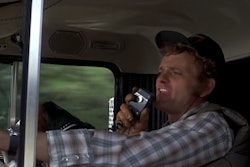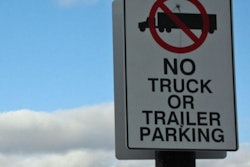More and more safety technology is moving from the lab to the real world.
Ed Cleek, a driver for McKenzie Tank Lines, has been using a lane-departure warning system for nearly a year. “I’ve gotten so used to it that I miss it when it’s turned off,” he says of the system that alerts him of possible fatigue when his truck begins to drift out of its lane. “It is an excellent safety tool.”
It is one of many safety accessories – not all of which are related to fatigue – that hold some promise for trucking. None is required by the government and none is in widespread use. That could change in the near future as some systems become more affordable and more truck makers offer them as options. However, any safety technology faces some roadblocks.
“No one knows at this point if any of these technologies will be considered for mandate,” says Liz Neblett, spokesperson for the National Highway Traffic Safety Administration. One controversial fatigue-related technology – electronic onboard recorders – could have been mandated by the Federal Motor Carrier Safety Administration along with the new hours-of-service rule, but FMCSA left it to further study.
“There is no single technology solution to the problem of fatigue,” says David Dinges of The University of Pennsylvania, a leading sleep researcher.

Furthermore, such technology isn’t high on truckers’ wish lists.
“Rather than raise wages to get more professional drivers behind the wheel, they spend all this money on machines to keep the idiots behind the wheel,” says Kurt Steffler, a 29-year owner-operator pulling for Jones Motor of Spring City, Pa. Forrest McDowell, an owner-operator with Warren Transport, believes such technology is a waste of money: “I run legal, and I sleep when I’m tired,” he says.
Although not all owner-operators see their value, some safety accessories are becoming commercially available, in some cases for less than $500. Here are the emerging technologies.
LANE DEPARTURE
One technology gaining some market acceptance is a camera system that alerts a drowsy driver that his truck is drifting out of its lane. Such systems use a camera to detect signs that indicate a lane, such as center lane markings, oil drops, reflectors or snow ruts.
One version, Iteris Inc.’s AutoVue Lane Departure Warning System, is offered by Freightliner as a factory-installed option on its Century Class S/T, Columbia and Argosy models.
Another, Safetrac, is offered in some Kenworth models and will be available from other truck makers by year’s end, says Dean Pomerleau of AssistWare, which makes the system.
“Safetrac operates effectively in more than 97 percent of highway conditions and gives false alarms less than once in every eight hours of driving,” according to AssistWare material.
Owner-operator Cleek, who uses Safetrac, says the system “can give false alarms in construction zones where old paint is still on the road.” Nevertheless, he says, “It keeps you on your toes even in situations where your attention wanders and you’re not necessarily tired.”
EYELID MONITOR
Research shows that drowsiness increases slowly over an hour or more. The Perclos system, which uses a dash-mounted camera trained on the driver’s eyes, provides early warnings of fatigue based on the frequency and length of eye closures. Perclos warns the driver with an audible signal and gives a readout of the distance he has traveled with closed eyes.
“Drowsy drivers often drive with their eyes closed for several seconds without realizing their eyes are actually closed,” says Richard Grace, who developed the system at Carnegie Mellon University in Pittsburgh, and who serves as CEO of Attention Technologies, which produces Perclos. “Eye closures of three to four seconds are common for drowsy drivers,” he says. In four seconds, a vehicle travels 360 feet at 60 miles per hour.
During two nights of testing with owner-operator Russ Schaefer, the Perclos camera warned of numerous eyelid closures. “I do plenty of night driving and this machine could really help me be more aware of when I need to sleep,” Schaefer says.
Grace expects the Perclos camera to be for sale this summer. Several fleets are conducting trials to help determine their interest in the product, he adds.
REST MEASUREMENT
The Sleep Watch, worn on the wrist, is a type of actigraph that tells time and measures the activity of the wearer for the past 24 hours. Based upon sleep standards, this measurement gives an indication of fitness for duty, whether the wearer has been on-duty or not. It tells the wearer the length and quality of his sleep as a percentage of available energy. A sleep reservoir below 65 percent is considered to be a sign the driver should not drive.
“There is a direct relationship between the amount of movement and the quality of sleep,” says Tom Kazlausky, vice president of Ambulatory Monitoring, a Sleep Watch testing and marketing firm.
The watch has a sensor that cancels out the mechanical movement of the truck and can discern if the watch has been taken off and put in a stable location. According to Kazlausky, “The watch can be fooled only by taking it off and allowing someone else to use it.”
The Sleep Watch will be for sale this year, Kazlausky says.
STEERING WHEEL MONITOR
The SAM G3 steering monitor provides feedback on a driver’s attentiveness by policing steering wheel movement. When a driver stops moving the wheel for 3.5 to 4 seconds, an alarm goes off. If the alarm sounds for more than one second, the SAM G3 will send a false brake signal to shut down the cruise control.
“The SAM monitors the driver at his closest point of contact with the vehicle,” says Harrison Smitson, vice president of sales for Electronic Safety Products, which has sold 1,500 units to U.S. fleets. The SAM G3 is available from some truck parts stores or directly from ESP in Indianapolis.
FRONT COLLISION WARNING
The Eaton Vorad EVT-300 Collision Warning System alerts the driver to objects in front of and to the passenger side of the vehicle.
The system also comes with a smart cruise component that, when used with cruise control, maintains a specified following distance behind the vehicle in front. It can distinguish among vehicles in the lane of travel and other lanes, and it is said to help drivers in situations of fog, rain and snow. Many dealers carry the system, and all truck makers offer it as an option.
NIGHT VISION
The Bendix XVision night vision system uses thermal imaging to let a driver see a bicyclist or a deer, for example, as far away as almost 1,500 feet. Objects appear as white on a black and white screen.
The system enables drivers to “see five times farther than with their regular headlights, giving them an extra 11 seconds (at 60 mph) to safely steer or stop their vehicle,” according to Bendix literature. Bendix is marketing this product through its distributors and dealers.
SIDE- AND REAR-VIEW CAMERAS
A side-view camera eliminates passenger-side blind spots; a rear-view camera also eliminates blind spots, which is helpful while driving as well as backing up. Considering that 27 percent of crashes occur while backing, killing 475 people last year and causing $220 million in damage, a rear visibility aid can offer a strong return on its investment.
Kenworth offers a side camera as an option for about $1,500, says spokesman Jeff Parietti. The company’s five-camera Surround Electronic Vision System “provides nearly 360 degrees of coverage around the tractor and trailer to enhance safety while driving and security while parked,” according to Kenworth’s website. “There are three cameras on the trailer, including one rear-view and two side-view,” says Kenworth Chief Engineer Jim Bechtold. The five-camera system remains in the concept stage.
REAR AND SIDE SENSORS
Some systems forgo cameras and use other sensing technology to alert the driver with a visual or audible alarm to what he cannot see, especially when backing. These systems work in rain and snow.
Delphi Delco Electronics Systems’ Forewarn, marketed by Pana-Pacific, uses radar to detect people or objects in a backing path up to 16.4 feet away. It is available at major truck dealers.
The Eagle Eye, made by Transportation Safety Technologies, consists of up to seven sensors mounted around the truck. It warns of obstacles within 10 feet of the vehicle.
The Rostra Rear Sentry’s warnings begin when an object is detected 12 feet away, then increase in intensity until the object is 3 feet away. The sensors also notice objects within 18 inches of the sides. The unit is available at truck parts stores.
ROAD ICE PREDICTOR
RoadWatch 3, developed by Commercial Vehicle Systems, formerly Sprague Controls, uses infrared technology to read air and road temperature. Changes in road temperature are displayed on a dash- or mirror-mounted LED unit. When the road temperature reaches 35 degrees, a light alerts the driver to the potential for black ice, the invisible coating of ice that can form before road temperatures reach freezing. “Nearly every snow plow in Pennsylvania’s entire fleet is equipped with RoadWatch,” says Anne Kinnamon of CVS.
RoadWatch is available at many dealerships or from some truck makers, including Mack and Volvo.
As RoadWatch and other safety products become more accepted in the market, prices will drop and they will become more affordable to the owner-operator. Even now, some are within the budgets of safety-conscious contractors with extra cash to spend. The gadget that seems futuristic and expensive today could be the equivalent of the seat belt tomorrow.
WIRED FOR STABILITY
Most of the emerging safety technology is not as important to safety as braking, says Duane Perrin, chief of crash avoidance research at the National Highway Traffic Safety Administration.
“Braking is involved in nearly every aspect of crash avoidance,” he says. Owner-operators should expect new stopping distance standards by 2007, which could make electronically controlled braking systems and air-disc braking necessary, Perrin says. Nevertheless, ECBS and air disc brake technology are difficult to find in the United States. “Fleets are testing it before buying,” he says.
Perrin says ECBS is available as an option from Freightliner. Volvo is testing ECBS with U.S. Xpress. Peterbilt is testing new disc brake technologies, says Chief Engineer Craig Brewster.
ECBS is called EBS in Europe, where it is a standard braking system used in conjunction with air disc brakes. American trucking is slow to accept this technology, given concerns about reliability and price.
ECBS will have a broader impact than many people realize because other safety technologies will become available once the entire truck is wired. ECBS improves braking with more precise wheel control and with brake wear sensors, says Tony Moore, Freightliner’s director of axle and brake systems. That will mean fewer jackknives and improved braking and maintenance standards.
Rollover stability and control technology, though not dependent upon ECBS, is available with ABS-equipped tractors and trailers with standard braking. Meritor Wabco’s Roll Stability Control senses a truck’s lateral acceleration. Long before the driver can feel that his vehicle is moving too fast sideways to remain upright, the electronic control module on the engine slows the truck by reducing engine torque, applying the engine brake and the air brake.
“Roll Stability Control works in turns and in avoidance maneuvers before the truck becomes destabilized,” says Mark Millstat of Meritor Wabco.











